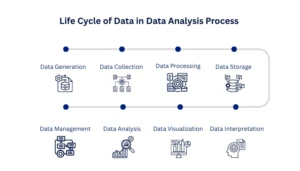New-age businesses, governments, and other organizations are always on the lookout for innovative or strategic solutions to drive further growth. One of the most powerful tools that such organizations leverage is data analysis. Data analysts and engineers are a worthy asset for such strategic growth, as they can translate the raw data into useful insights. These insights can be strategically applied for the improvement of the organization and to maximize profits. The field of data analysis is not 1 process of converting data into insights. It is an entire spectrum of various techniques and approaches used to draw desirable insights from raw data. It is utilized by major businesses for data strategy and management, boosting growth. In this blog, we shall uncover 8 types of data analytics for better decision-making.
What Is Data
Data is everything, every detail you enter when you go to a website, your name, your preferences, your age, location, and your purchase. Moreover, this was just about general customer data; there are a lot of other things that can be classified as digital data, and this data is used as a treasure mine of information to get insights and create strategies accordingly. Data analysis is the process that observes, analyzes, classifies, and provides insights from the random data and details. Now, let us see the 4 major types of data analysis. These are not just types, but the 4 approaches business owners can consider as per their needs.
4 Main Types of Data Analytics for Decision Making
The 4 main types of data analytics are like 4 different approaches of how you wish to use your data. Do you wish to study what happened in the past, or be prepared for what may happen in the future, or perhaps both of them? To understand which approach you should implement for your business, it is important to understand these 4 main types of data analytics.
Descriptive Type of Data Analytics
Descriptive analytics is the basic lever of data analysis. This analysis examines what happened in the past through historical data. It is helpful to understand everything that happened in the past year or past month to draw a conclusion and decide accordingly for the future. Descriptive analysis answers one basic question: “What happened?”. It is like a monthly, quarterly, or annual report of activities, profits, or losses, the organization went through in a nutshell. Descriptive analytics helps in summarizing and visualizing data trends, for example, the increase in sales over the weeks for a certain product, while a comparative decline in the demand for another product. Such reports help understand the issues in the current organization and bring them to the attention of decision makers.
Descriptive analysis is used in organizations to create dashboards, reports, and data visualizations to understand past performance. It also helps keep track of organizations’ performance over the years. The use of such dashboards in US organizations has increased by over 45% in the leading firms. This helps identify patterns, recurring trends, and potential concerns or opportunities.
Diagnostic Type of Data Analytics
While descriptive analysis tells us what happened in the past, diagnostic analysis tells us why it happened. This approach of data analysis digs deeper into the event and identifies the root cause of that event. If sales of a certain product are increasing, a diagnostic approach will help organizations understand if it is because of the new marketing campaign or something else. This also applies to negative events like customer churn or decline in sales. Diagnostic analytics answers the question: Why did it happen? Once you know the reason for profits, you can repeat the cause and enjoy multiple profits. On the other hand, if you know the reason for the loss, you can prevent it in the future. The diagnostic analytics sometimes leverage advanced statistical techniques like hypothesis testing and data mining.
Predictive Type of Data Analytics
Predictive Analysis is a step ahead of the other 2 types of data analytics we have seen. It speaks of the future, based on the past and present. Predictive analytics makes predictions about what is most likely to happen in the future based on historical data patterns and real-time updates. Predictive analysis provides organizations with the opportunity to take proactive actions for the prevention of harm or maximizing profits, before they happen. Machine learning algorithms and statistical modelling are usually utilized in predictive analytics. Business owners can use predictive analytics to anticipate customer demands, predict churn, and sometimes, to detect fraud. A report suggests that about 77% of financial institutions use predictive analysis in their operations.
Prescriptive Type of Data Analytics
Prescriptive analytics is the most advanced form of data analysis. It goes beyond description, diagnosis, and predictions to provide corrective suggestions. This one among all the types of data analytics is highly valuable in improving operational efficiency. Prescriptive analytics is dependent on optimization algorithms and simulation models for the evaluation of several scenarios and suggests the best actions. Prescriptive analysis automates decision-making to some extent and thus saves time and empowers organizations to make faster and more informed decisions.
Make decisions that matter – Discover the right approach to data analysis for improved decision making
Specific Types of Data Analytics
Now that we have seen the approaches for which data analytics can be used, let us also see some ways it can be used. These are 4 specific types of data analytics.
Text Analytics
Text analytics, also known as Natural Language Processing (NLP) or text mining, is a specialized analysis focusing on unstructured textual data. Now, when a vast amount of data is easily available in the form of text documents, social media posts, e-mails, and customer reviews, text analytics can extract insights from these sources.
Text analytics involves sentiment analysis, topic modelling, and entity recognition etc. Business owners can use this type of analysis to gain insights into customer feedback, social media sentiment, and market trends. This analysis helps understand customer preferences, guides better content creation, and identifies emerging issues.
Spatial Analytics
Spatial analytics deals with location-based data. It is crucial for organizations and businesses that depend on location information, like retail, logistics, and urban planning. This analysis type can help with decisions related to site selection, route optimization, or disaster management. The global market value of spatial analytics was at USD 38.3 billion, which is projected to grow at a 13.6% CAGR and reach USD 106 billion by 2034. Geographic Information Systems (GIS) are commonly used tools in spatial analytics. They allow organizations to understand how locations affect their operations, customer distribution, and other things like delivery and returns.
Cluster Analysis
The clustering or segmentation analysis creates groups of similar data points together, based on certain features. This technique helps discover hidden patterns or relationships within a dataset. Cluster analysis is a way to reveal the natural grouping already existing in raw data without predefined categories. This type of analysis can help create customer segmentation for businesses to optimize marketing campaigns that work.
Social Network Analysis
The social network analysis focuses on understanding the relationships, connections, and influence within an interconnected digital ecosystem like social networks. This type of analysis is useful for businesses that utilize the power of social media through marketing, customer engagement, and brand management. This type of data analytics uses graph theory and network metrics to analyze the relationship between individuals, organizations, or entities.

Benefits of Using Data Analysis
The use of data analytic methods offers multiple benefits to your organization which including
- Increased efficiency
- Decreased costs
- Time saving
- Proactive approach
- Risk mitigation
- Fraud detection
- Customer understanding
- Performance tracking
- Improved decision-making
Conclusion
Data Science is a huge field with multiple techniques, approaches, and use cases specific to several industries. The above-mentioned 8 types of data analytics are the major classifications of the data analysis concept that help businesses make appropriate use of it. To strategically utilize your data treasure, get in touch with some reliable data analytics service providers. They will help you extract useful insights from raw customer data. For expert analytic services as well as AI development services, connect with AnavClouds Analytics.ai and book a demo session soon.
FAQs
What are the 4 main types of Data Analysis?
The 4 main types of data analysis are descriptive, diagnostic, predictive, and prescriptive analysis. These types of data analysis provide answers to major organizational questions like what events happened, what caused the event, what events may happen, and what measures can be taken in the future for positive impact.
What are the 8 steps of data analysis?
The 8 overall steps of data analysis are 1) defining the problem, 2) collecting the data, 3) cleaning the data, 4) analyzing the data, 5) interpreting the results, 6) visualizing the data, 7) sharing the findings, and 8) assessing and acting upon it.
How does data analysis help in decision making?
With data analysis, the decision making is backed up by solid data-based evidence rather than random guesswork. Data-driven decisions are more practical and more likely to give desired results.
What is the main purpose of data analysis?
The main purpose of data analysis is extracting useful information from raw data. This helps in making informed decisions, improving operations, and gaining more profits.
Who benefits from data analysis?
Data analysis in general is useful to all kinds of organizations, governments, and projects. However, data analysis is the most beneficial tool for businesses across industries.



